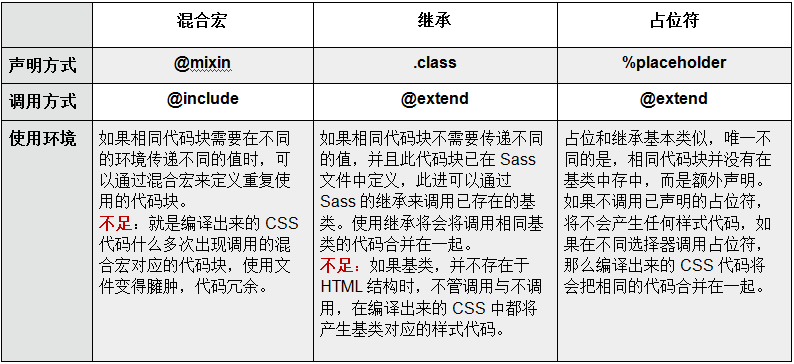全局变量/局部变量
创建变量用$符号开头。
创建变量的条件:
- 该值至少重复出现了两次;
- 该值至少可能会被更新一次;
- 该值所有的表现都与变量有关(非巧合)。
注意:当在局部范围(选择器内、函数内、混合宏内…)声明一个已经存在于全局范围内的变量时,局部变量只会在局部范围内覆盖全局变量。
1
2
3
4
5
6
7
8
9
10
11
|
$color: orange !default; //定义全局变量
.block {
color: $color; //调用全局变量
}
em {
$color: red; //定义局部变量(全局变量 $color 的影子)
a {
color: $color; //调用局部变量
}
}
|
嵌套
嵌套的三种类型:
选择器嵌套:
1
2
3
4
5
6
7
8
9
|
nav {
a {
color: red;
header & {
color: green;
}
}
}
|
编译出来之后:
1
2
3
4
5
6
7
|
nav a {
color: red;
}
header nav a {
color: green;
}
|
属性嵌套:
1
2
3
4
5
6
7
|
.box {
border: {
top: 1px solid red;
bottom: 1px solid green;
}
}
|
编译出来之后:
1
2
3
4
5
|
.box {
border-top: 1px solid red;
border-bottom: 1px solid green;
}
|
伪类嵌套:
1
2
3
4
5
6
7
8
9
10
11
12
|
.clearfix {
&:before,
&:after {
content: '';
display: table;
}
&:after {
clear: both;
overflow: hidden;
}
}
|
编译出来之后:
1
2
3
4
5
6
7
8
9
10
|
clearfix:before,
.clearfix:after {
content: '';
display: table;
}
.clearfix:after {
clear: both;
overflow: hidden;
}
|
混合宏@mixin
声明混合宏
@mixin 是用来声明混合宏的关键词。
1
2
3
4
| @mixin border-radius {
-webkit-border-radius: 5px;
border-radius: 5px;
}
|
1
2
3
4
| @mixin border-radius($radius: 5px) {
-webkit-border-radius: $radius;
border-radius: $radius;
}
|
1
2
3
4
5
6
7
8
9
10
| @mixin box-shadow($shadow...) {
// 带有多个参数,可以使用“ … ”来替代。
@if length($shadow) >= 1 {
@include prefixer(box-shadow, $shadow);
} @else {
// 当 $shadow 的参数数量值大于或等于“ 1 ”时,表示有多个阴影值,反之调用默认的参数值“ 0 0 4px rgba(0,0,0,.3) ”。
$shadow: 0 0 4px rgba(0, 0, 0, 0.3);
@include prefixer(box-shadow, $shadow);
}
}
|
调用混合宏
匹配了一个关键词@include来调用声明好的混合宏。
- 不传参数
1
2
3
4
|
button {
@include border-radius;
}
|
编译出来之后:
1
2
3
4
5
|
button {
-webkit-border-radius: 3px;
border-radius: 3px;
}
|
- 传一个不带值的参数
1
2
3
4
5
6
7
8
|
@mixin border-radius($radius) {
-webkit-border-radius: $radius;
border-radius: $radius;
}
.box {
@include border-radius(3px);
}
|
编译出来之后:
1
2
3
4
| .box {
-webkit-border-radius: 3px;
border-radius: 3px;
}
|
- 传一个带值的参数
1
2
3
4
5
6
|
@mixin border-radius($radius: 3px) {
// 传了一个参数“$radius”,而且给这个参数赋予了一个默认值“3px”。
-webkit-border-radius: $radius;
border-radius: $radius;
}
|
当不写的时候取值为默认:
1
2
3
| .btn {
@include border-radius;
}
|
编译出来之后:
1
2
3
4
| .btn {
-webkit-border-radius: 3px;
border-radius: 3px;
}
|
当写的时候取值为写入的值:
1
2
3
| .box {
@include border-radius(50%);
}
|
编译出来之后:
1
2
3
4
| .box {
-webkit-border-radius: 50%;
border-radius: 50%;
}
|
- 传多个带值的参数
1
2
3
4
5
6
7
8
9
10
11
12
13
|
@mixin center($width, $height) {
width: $width;
height: $height;
position: absolute;
top: 50%;
left: 50%;
margin-top: -($height) / 2;
margin-left: -($width) / 2;
}
.box-center {
@include center(500px, 300px);
}
|
编译出来之后:
1
2
3
4
5
6
7
8
9
| .box-center {
width: 500px;
height: 300px;
position: absolute;
top: 50%;
left: 50%;
margin-top: -150px;
margin-left: -250px;
}
|
有一个特别的参数…。当混合宏传的参数过多之时,可以使用一个参数来替代所有参数。——box-shadow:0px 3px 1px #000
混合宏在实际编码中给我们带来很多方便之处,特别是对于复用重复代码块。但其最大的不足之处是会生成冗余的代码块。
扩展/继承@extend
在 Sass 中是通过关键词 @extend来继承已存在的类样式块,从而实现代码的继承。
1
2
3
4
5
6
7
8
9
10
11
12
13
14
15
16
17
18
|
.btn {
border: 1px solid #ccc;
padding: 6px 10px;
font-size: 14px;
}
.btn-primary {
background-color: #f36;
color: #fff;
@extend .btn;
}
.btn-second {
background-color: orange;
color: #fff;
@extend .btn;
}
|
编译出来之后:
1
2
3
4
5
6
7
8
9
10
11
12
13
14
15
16
17
|
.btn,
.btn-primary,
.btn-second {
border: 1px solid #ccc;
padding: 6px 10px;
font-size: 14px;
}
.btn-primary {
background-color: #f36;
color: #fff;
}
.btn-second {
background-clor: orange;
color: #fff;
}
|
占位符 %placeholder
取代以前 CSS 中的基类造成的代码冗余的情形。因为 %placeholder 声明的代码,如果不被 @extend 调用的话,不会产生任何代码。
1
2
3
4
5
6
7
8
9
10
11
12
13
14
15
16
17
18
19
20
21
|
%mt5 {
// 如果没被@extend 调用,不会产生任何代码块。只有通过 @extend 调用才会产生代码:
margin-top: 5px;
}
%pt5 {
padding-top: 5px;
}
.btn {
@extend %mt5;
@extend %pt5;
}
.block {
@extend %mt5;
span {
@extend %pt5;
}
}
|
编译出来的 CSS
1
2
3
4
5
6
7
8
9
10
|
.btn,
.block {
margin-top: 5px;
}
.btn,
.block span {
padding-top: 5px;
}
|
混合宏 VS 继承 VS 占位符
Sass 中的混合宏使用
总结:编译出来的 CSS 清晰告诉了大家,他不会自动合并相同的样式代码,如果在样式文件中调用同一个混合宏,会产生多个对应的样式代码,造成代码的冗余,但是@mixin 可以传参数。
个人建议:如果你的代码块中涉及到变量,建议使用混合宏来创建相同的代码块。
Sass 中继承
总结:使用继承后,编译出来的 CSS 会将使用继承的代码块合并到一起,通过组合选择器的方式向大家展现,比如 .mt, .block, .block span, .header, .header span。这样编译出来的代码相对于混合宏来说要干净的多,但是他不能传变量参数。
个人建议:如果你的代码块不需要专任何变量参数,而且有一个基类已在文件中存在,那么建议使用 Sass 的继承。
占位符
总结:编译出来的 CSS 代码和使用继承基本上是相同,只是不会在代码中生成占位符 mt 的选择器。那么占位符和继承的主要区别的。
“占位符是独立定义,不调用的时候是不会在 CSS 中产生任何代码;继承是首先有一个基类存在,不管调用与不调用,基类的样式都将会出现在编译出来的 CSS 代码中。”
来看一个表格:

